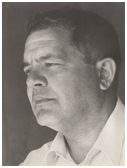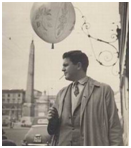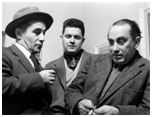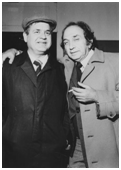They will say of me: “He was clumsy,
rude, vain, with a
ruined liver and a peasant accent.”Tito Balestra, Diranno,
from Quiproquo, Garzanti, 1974
BIOGRAPHY

«We would meet Tito in the evening, at Chiurazzi’s “Vetrina”. His head tilted back, his heavy eyelids, his cigar butt, and his silence in conversations. He spoke rarely but always conclusively. Like a magician he occasionally made a print appear from the folds of his clothes, by Goya or Daumier, or an epigram,. He was a cultured, secret man, a sure friend, on whom you could count, disinterested and uncompromising .” These are the words of Renato Guttuso describing his friend.
A particular, enigmatic figure and a refined art lover; Tito Balestra was born in Longiano on July 25th 1923, to Flaminio and Santa Urbini. After compulsory school, he enrolled at the Istituto Magistrale of Forlimpopoli and in 1939 at the Faculty of Languages of the University of Venice, which he abandoned in 1942 for the Faculty of Magisterium of Urbino, which he also left due to the professors «who did not recognize the students’ independent judgement.»
Between 1941 and 1946 he took part in the partisan struggle, earning a “Patriot Certificate“; his civic commitment led him to assume, for a short time and against his will, first the role of councillor, and then (in June 1945 for just two weeks) that of deputy mayor, under the guidance of Giovanni Sesto Menghi, the mayor but also painter and president of the local National Liberation Committee. In those same years Tito began his collaboration with some newspapers and magazines such as «Il Resto del Carlino», «Il Corriere Padano», «Il Corriere Cesenate», «Il Trebbo», «La Piè».
A central event in the poet’s life was his move to Rome in September 1946 (where Attilio Bertolucci believed he lived there “not as a nostalgic but as a suffering provincial “) to follow, having won a scholarship, the courses at Cepas (Centre of Professional Education for Social Workers) directed by Guido Calogero; there he met his future wife Anna Maria De Agazio.

He wrote to a friend in December of the same year:
«Since I’ve been in Rome, I haven’t written a single word. To be honest, [I did write] some quite shabby verses. There is nothing to do dear Cino, when laziness is congenital.
You delude yourself from the beginning. Changes in the environment, a more intense life, new elements. Lies. Once you get over the initial interest you fall back. And you become pessimistic; if the word seems big to you, dissatisfied.
And when you’re about to sink because you’ve lost your confidence, an inconvenience happens unexpectedly. Like me. Just laugh; and I see you laugh; nor can you do anything else, if I clarify the genre. Sentimental. It doesn’t seem true to you, does it? The cynical Balestra, that idiot who believes he is the master of himself, of dominating his impulses, on the way to having a crush. An intellectual crush, poetry procuress. Can you imagine an intermediary Montale? A Lorca perhaps, is understandable. But the miracle (or the trouble) of D’Ossi di Seppia, no.»
Right in the streets of the Eternal City, Tito, through his Bolognese friend Arnaldo Bartolini, met Tanino Chiurazzi, with whom he quickly became a friend, and who, in the same year, had opened the art gallery “La Vetrina” (“The Window Display”) in Via del Babuino, where he organized temporary exhibitions. In the gallery in Via del Babbuino Tito became friends with artists, writers and collectors, even with those who came from Florence, Bologna, Genoa, Milan and Messina, on several occasions known in the editorial offices of newspapers, including: Alvaro, Bartolini, Bassani, Belli, Bilenchi Bonuglia, Cassola, Comisso, Consagra, Cugurra, Dalla Chiesa, D’Arrigo, Delfini, De Libero, De Pisis, Della Ragione, Flaiano, Frattini, Gatto, Guttuso, Leoncillo, Longanesi, Maccari, Mafai , Mazzullo, Mezio, Velso and Dora Mucci, Natta, Omiccioli, Palazzeschi, Pannunzio, Penna, Perilli, Pirro, Raimondi, Reale, Paolo Ricci, Sacripante, Sinisgalli, Sonego, Stradone, Tallarico, Tomea, Ciccio Trombadori, Ungaretti, Valsecchi, Vicars, Vivaldi.

He regularly followed the progress of his friend’s gallery and the curation of exhibitions that allowed him to get to know in depth the work of the artists he had begun to love and meet again in their studios: Rosai, Mafai, Maccari, Enotrio, Tomea, Manzù, Morandi, Vespignani, Vangelli and Guttuso.
He thus became an exceptional witness of the great Roman season (first in Chiurazzi’s gallery , then in Giuliano de Marsanich’s “Don Quixote”) and, in these years, he also began collecting works for his own tasteful art collection and totally personal use.
Peculiar, among others, is his friendship with Mino Maccari, with whom he met on numerous occasions and who will, in 1956, be Tito’s best man at his wedding. In 1966 Tito organized a solo exhibition for the artist in Longiano.
Parallel to his love for art, Balestra continued to cultivate his “necessary” passion for poetry and writing, revealed, from time to time, through collaboration with newspapers (including «Il Mondo», «Il Tempo Presente », «L’Avanti», «L’Italia Socialista», «Il Caffè», «Botteghe Oscure») and subsequently with the publication of some poetic collections.

«Balestra is a poet – as Alfonso Gatto wrote – who was in no hurry to get published, he is a poet who only his friends knew wrote poems, epigrams, satires and who gave everyone self-confidence, first of all with his human behavior , with his human choices, with his good humor, with his bad mood, with the taste for life that he always communicated to us. Balestra’s poetry is not limited to the satirical and the tragic. Balestra’s poetry is also the culture it has of itself poetically, it is a poetry that in its apparent popular immediacy is very cultured, nourished by good blood and ancient brewing. »
Balestra’s poetry, claimed Attilio Bertolucci «[…] almost never has depths of colour, it is in black and white, without smudges, like the graphical Maccari. […] Tito Balestra is not a new poet, he is a different poet who does not seek diversity, instead he finds it in himself.»
Balestra’s poetic work was published in a book for the first time in 1974, when L’Arco Edizioni d’Arte published Se hai una montagna di neve tienila all’ombra (If you have a heap of snow, keep it in the shade), accompanied by six etchings by Maccari, chosen in a sample collection made by the artist specifically for that purpose; in the same year Garzanti published another collection: Quiproquo (Quid pro quo / Misunderstanding). In 1975, L’Arco Edizioni printed fifty-two copies of Le gambe del serpente (The snake’s legs), eleven poems on the occasion of Tito’s fifty-second birthday, and in 1976 Oggetto: la Via Emilia (Object: the Via Emilia), with four etchings by Alberto Sughi.
Tito Balestra died in Longiano on October 19th 1976.
On the same day of his death, Milanese publishing house All’Insegna del Pesce d’Oro by Vanni Scheiwiller published Poesie di Liestal, with the words of Alfonso Gatto pronounced at the Arco on 7 November 1975 and three illustrations by Henry Goetz.
